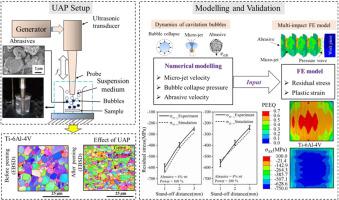International Journal of Machine Tools and Manufacture ( IF 14.0 ) Pub Date : 2023-11-23 , DOI: 10.1016/j.ijmachtools.2023.104100 Rahul Yadav , Nilanjan Das Chakladar , Soumitra Paul

|
The present study proposes a novel method of ultrasonic vibration assisted-abrasive peening for the enhancement of residual stress on the surface of metals and their alloys. The system employs a vibrating sonotrode that drives the formation and collapse of bubbles within a fluid medium. The imploding bubbles produce pressure waves which transfer momentum to the abrasives which are uniformly distributed in the fluid medium. The abrasives bombard a targeted surface along with intense pressure waves. This induces compressive residual stress through local plastic deformation in a short period. The capability of the ultrasonic-assisted abrasive peening setup is analysed in terms of residual stress by altering the abrasive concentration, peening time, and stand-of-distance between the bottom of the sonotrode and the exposed surface to be treated. The process is able to induce significant residual stress at around 67 % of yield strength for hard material Ti–6Al–4V and more than 80 % of yield strength for ductile materials, Al-6061 and OFHC-Cu. A numerical method coupled with a finite element model is employed to predict the dynamics of the process from cavitation of the bubble to the plastic deformation of the work material. At first, the model estimates the magnitudes of high-pressure waves at the bubble implosion near the solid surface, micro-jet velocity, and abrasive velocity. This information is then fed to Abaqus for numerical modelling of the deformation of work material. The impact of high-speed abrasives in the range of 100 m/s, pressure waves and microjets at the material surface are simulated through the FE model. The simulated results are verified with experimental findings in terms of surface residual stress for different materials, deviating within 10 %.
中文翻译:

金属合金液体空化中超声波振动辅助喷丸残余应力的调整
本研究提出了一种超声波振动辅助喷丸的新方法,用于增强金属及其合金表面的残余应力。该系统采用振动超声波发生器来驱动流体介质内气泡的形成和破裂。内爆的气泡产生压力波,将动量传递给均匀分布在流体介质中的磨料。磨料伴随着强烈的压力波轰击目标表面。这会在短时间内通过局部塑性变形产生压缩残余应力。通过改变磨料浓度、喷丸时间以及超声焊极底部与待处理的暴露表面之间的距离,从残余应力方面分析超声波辅助磨料喷丸装置的能力。该工艺能够在硬质材料 Ti-6Al-4V 的屈服强度约 67% 的情况下产生显着的残余应力,而在延性材料 Al-6061 和 OFHC-Cu 的屈服强度超过 80% 的情况下产生显着的残余应力。采用数值方法与有限元模型相结合来预测从气泡空化到工作材料塑性变形的过程动力学。首先,该模型估计固体表面附近气泡内爆时高压波的大小、微射流速度和磨料速度。然后将该信息输入 Abaqus,对工作材料的变形进行数值模拟。通过有限元模型模拟了100 m/s范围内的高速磨料、压力波和微射流对材料表面的冲击。模拟结果与不同材料表面残余应力的实验结果进行了验证,偏差在10%以内。












































 京公网安备 11010802027423号
京公网安备 11010802027423号